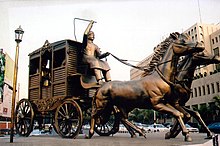Dhakaiya Kutti
| Dhakaiya Kutti dialect | |
|---|---|
| Old Dhakaiya Bengali | |
| ঢাকাইয়া কুট্টি পুরাণ ঢাকাইয়া (Puran Dhakaiya) | |
| Native to | Bangladesh |
| Region | Old Dhaka |
Indo-European
| |
| Bengali alphabet | |
| Language codes | |
| ISO 639-3 | – |
| Glottolog | vang1242 Vanga |
Dhakaiya Kutti dialect (
Features
Dhakaiya Kutti is an
| English | Standard Bengali | Dhakaiya Kutti |
|---|---|---|
| Boy | Chhele (ছেলে) | Pola (পোলা) |
| Girl | Meye (মেয়ে) | Meya (মেয়া) |
| Youngsters | Chhelemeye (ছেলেমেয়ে) | Polapain (পোলাপাইন) |
| True | Shotti (সত্যি) | Sotti (সত্যি)/Hacha (হাছা) |
| Why | Keno (কেন) | Kela (ক্যালা) |
| How | Kemon (কেমন) | Kemte (কেমতে) |
| Listen | Shon (শোন) | Son (সোন)/Hon (হোন) |
| After drinking tea | Cha kheye (চা খেয়ে) | Cha khaiya (চা খাইয়া) |
| You'll go with me? | amar shonge jaben naki? (আমার সঙ্গে যাবেন নাকি?) | amar loge jaiben niki?(আমার লগে যাইবেন নিকি?)[6] |
| What did you buy from market? | Bazar theke ki kinechhen? (বাজার থেকে কি কিনেছেন?) | Bazar theika/thon ki kinchhen? (বাজার থেইকা/থন কি কিনছেন?)[6] |
| From | theke (থেকে) | theika (থেইকা)/thon (থন)[6] |
| Banana | kola (কলা) | kolla (কল্লা)[6] |
| Gourd/pumpkin | lau/kodu (লাউ/কদু) | koddu (কদ্দু)[6] |
| But | kintu (কিন্তু) | mogor (মগর), magar - from Persian[6] |
| Me too | amio (আমিও) | ami bi (আমি বি) bhi - from Hindustani[6] |
| All | shob (সব) | sob (সব/ছব)[6] |
| I see | dekhi (দেখি) | dehi (দেহি)[6] |
| Going (perfect participle) | giye (গিয়ে) | giya (গিয়া)/jaiya (যাইয়া)[6] |
| I'm doing (present continuous) | ami korchhi (আমি করছি) | ami kortechhi (আমি করতেছি) |
| I will do | korbo (করবো) | kormu (করমু) |
History

| Part of a series on the |
| Culture of Bangladesh |
|---|
 |
During the
Presently, the speakers of kutti dialect are a minority in
Literature and media
There has been literature written in the Dhakaiya Kutti dialect. One popular poem is "Channi-poshor Raiter Lour" (চান্নিপশর রাইতের লৌড়) by Jewel Mazhar.[12] Dhakaiya natoks are popular throughout the country and even the Indian filmmaker, Satyajit Ray, has written dialogues in this dialect.[13] The Dhakaiya Kutti folk are renowned for "Kutti Jokes" and the dialect's humorous aspect in general; generally consisting of short stories in which Dhakaiyas mess around with the bhadralok gentry.[14] It is considered to be one of the wittiest among Bengali dialects.[15] Generally referred to as "Dhakaiya" folk, they call outsiders or non-Dhakaiya Bengalis by the name "Gaiya" (গাঁইয়া), meaning from the village,[16] and Kolkatans in particular as Demchi (ডেমচি).[17]
Further reading
- Bhuiyan, Mosarrof Hossain ঢাকাইয়া কুট্টি ভাষার অভিধান - Dictionary of words in Bengali dialect spoken in Dhaka City, popularly known as Dhakaiya Kutti Dialect. (Oitijjhya, 2015)
References
- ASIN B000B9G89C.
- ASIN B000B9G89C.
- ^ Prof. Dr. Hafiza Khatun (17 Jan 2017). Dhakaiyas and Gentrification in Old Dhaka (PDF). Asiatic Society of Bangladesh. p. 4. Archived from the original (PDF) on 5 May 2020. Retrieved 19 February 2020.
- ^ OL 30677644M. Retrieved 3 June 2024.
- ^ ঢাকাইয়া কুট্টি ভাষার অভিধান-মোশাররফ হোসেন ভূঞা-প্রকাশনা: ঐতিহ্য-রুমী মার্কেট ৬৮-৬৯ প্যারীদাস রোড-বাংলাবাজার ঢাকা ১১০০
- ^ a b c d e f g h i j k l Khan, Akhtar Hamid (21 January 2019). ঢাকার ভাষা. The Daily Sangram (in Bengali).
- ^ Ahmad Mirza Khabir (1995). Shotoborsher Dhaka (in Bengali). Rashid Hasan.
- ^ Bhowmik, Satya N (1993). Die Sprachenpolitik Der Muslim-League-Regierung und Die Entstehung Der Bengali-Sprachbewegung in Ostbengalen: 1947 - 1956 (in German). F Steiner. p. 60.
- ^ ঢাকাইয়া কুট্টি ভাষার অভিধান-মোশাররফ হোসেন ভূঞা-প্রকাশনা: ঐতিহ্য-রুমী মার্কেট ৬৮-৬৯ প্যারীদাস রোড-বাংলাবাজার ঢাকা ১১০০
- ^ Dr Faheem Hasan Shahed (16 Jul 2012). "Enthralling seminar on 'Dhakaiya Kutti' language and humor". American International University-Bangladesh.
- ^ Rajshahi University.
- ^ কলকাতার সল্টলেকে ঐহিক'র নিবিড় সাহিত্য-আড্ডা. Banglanews24.com (in Bengali). 13 Feb 2020.
- ^ Haider, Daud (2 May 2019). "Daud Haider remembering Satyajit Ray: সত্যজিৎ ও ঢাকাইয়া কুট্টি". The Indian Express.
- ^ Bandopadhyay, Bhanu. "Atmokotha". Bhanu Samagra. pp. 17–20.
- ^ Alam, Shahid (21 Feb 2013). "Reflections on a contemporary phenomenon". The Daily Star.
- ^ Akhtar Imam (1988). Durer Chhaya. p. 7.
- ^ Jalil, Azizul (2006). Turbulence and tranquillity. p. 20.
